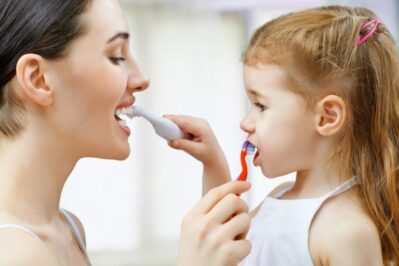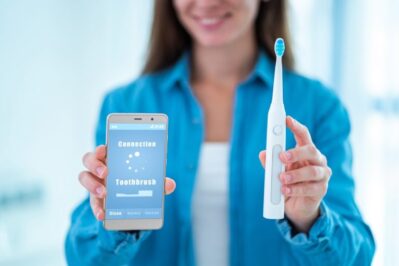The tools we use to clean our teeth just keep improving, from early sticks and hog’s hair toothbrushes to today’s wide array of electric toothbrushing devices. In our orthodontic practice, patients often want to know which type of toothbrush is best for their teeth.
Is there something wrong with using the toothbrush your dental orthodontics professional may provide you for free? Let’s brush off the facts and consider the pros and cons of using an electric toothbrush vs. a manual toothbrush.
The Tried And True Manual Toothbrush

Properly used and combined with regular flossing, a manual toothbrush provides good results.1 Using a manual toothbrush well relies on good technique, accurate timing, strength, and coordination.
Some of the advantages of using a manual toothbrush include:
- A variety of options available. You can choose a manual toothbrush of almost any shape, size, or bristle firmness level, although your dentist or local orthodontist will most likely recommend soft bristles. Manual toothbrushes may also come in your child’s favorite theme or character, encouraging brushing for younger kids.
- Less expensive. The price gap between electric toothbrushes vs. the manual variety makes it easier to use a manual toothbrush, which can be purchased for a few dollars or less. Many dentists and local orthodontists provide them to their patients at no charge.
- Always ready to use. Without the need for charging or fresh batteries, a manual toothbrush is a low-tech and easy-to-use solution for cleaning your teeth. Even if you have an electric toothbrush, it’s still a good idea to have a manual toothbrush available in case of power outages or charging station failures.
- Ready to travel. Manual toothbrushes are small and portable, and travel versions that protect the bristle heads are readily available. If you travel outside the country, you may encounter power outlets that will not safely charge your electric toothbrush without an adapter.
- Personal preference. Some people do not like the vibrations or sensations of certain types of electric toothbrushes. Using a manual toothbrush is far superior to owning a device that you dread using.
Disadvantages of manual toothbrushes:
- Difficult for some people to use properly. Young children and older people may not have the physical strength or motor ability to use a manual toothbrush long enough to do the job. An electric toothbrush is often easier for these people to use.
- The tendency to skimp on brushing your teeth. Many of us are in a rush in the morning, may not brush our teeth during the day, and then are tired and sleepy for nighttime chores. While you might be aware of the proper brushing technique, it can be hard to keep quality standards high when you are in a hurry. Your local orthodontist might call this “drive-by brushing.”
- The consequences of improper use. When using a manual toothbrush, the results all depend on brushing correctly, often, with the right amount of pressure, and flossing well. When we don’t, the results are not nearly as good as the same effort applied with an electric toothbrush. Bad breath, gingivitis, and tooth decay can be the result.
Going High-tech On Your Teeth

An orthodontic practice or local dental center sees the results of poor brushing habits up close every day. Let’s face it. It is hard to brush your teeth with a manual toothbrush and achieve the same results as the new technology can provide. Your doctor may recommend an electronic toothbrush and will almost certainly be happy to discuss the options if you bring your questions up.
That is because, although not all electric toothbrushes are created equal, the top brands share these advantages:
- Timers and aids encourage the best brushing technique. Many electric toothbrushes feature timers that remind you how long to brush and when to move to the next “quadrant” or area of your mouth, and they warn you if you are brushing too hard.
- Thousands of strokes per second make the best use of your time and removes the tendency to brush one side of the mouth more thoroughly than the other.
- There’s better removal of debris and plaque below the gum line. An electric toothbrush is designed to clean in crevices and places a manual toothbrush cannot reach, often promoting better gum health.
- You’ll experience less time with your hygienist. We might enjoy our dental hygienist’s company, but most of us will enjoy less scraping of plaque at regular dental cleaning appointments. Top-level electronic toothbrushes have a noticeable effect on lowering plaque buildup, some dentists report.1
- Your teeth feel cleaner after brushing. You know the smooth and polished feel your teeth have after a professional cleaning at the dentist? Many users of electronic toothbrushes enjoy this feeling every day and report that it is a noticeable difference over manual tooth brushing.
- They are popular with kids while promoting good habits. Many children can’t wait to graduate to the higher-tech toothbrush, and they enjoy the feeling of the fast-moving bristles, saying it “tickles.” Meanwhile, the toothbrush reinforces proper brushing time and technique, meaning less nagging from parents concerned about their children’s teeth. Especially with braces, an electric toothbrush makes the job easier and more independent for kids.
- Electric brushes prevent or treat gum disease and gingivitis. Our gums become inflamed when small particles of food are missed during brushing. Massaging your gums and cleaning under the edges of gum tissue manually can be challenging for most of us. Electric toothbrushes often improve gum health and even reduce bad breath.
Of course, not every tool is right for every person. Some of the reasons people may choose not to use an electric toothbrush vs. a manual one include:
- Cost of investment and replacement: With some top models costing between $100-$200, and replacement bristle heads needed every 3-6 months, many people steer clear of electric toothbrushes because the cost seems too high.
- Waiting for shared base units: One way to reduce the cost is to purchase a single high-quality electric model, and then different bristle heads for each family member. The downside of this is waiting for the power unit or finding someone else did not place the base on its charger.
- Storage issues: The standard “toothbrush holder” mounted on the bathroom wall will often not hold separated brush heads reliably and will not hold the base unit at all. Where and how to store these items might put your creativity to the test or might be as simple as a silverware separator in your bathroom drawer to store the accessories and equipment.
- Dissatisfaction with the first type tried: When electric toothbrushes first came out, some of them needed improvement. The vibration level might have been uncomfortable or the results did not live up to the claims. Not only has the cost come down over the years, but their quality has improved. Still, many people who return to the manual toothbrush are hesitant to invest again in an electric model for fear of similar disappointment.
What Are The Different Types Of Electric Toothbrush?
There are several different types of electric toothbrushes and, while they vary in the method they use to clean your teeth, there is limited research showing one type to be better than another. Dental orthodontics professionals often recommend one particular type to their patients, so be sure to discuss this with your doctor.
- Rotary toothbrushes, where the bristle head moves in a circular direction and which may or may not alternate, usually run at about 3000-7500 rotations per minute.
- Sonic toothbrushes, which move side to side at over 30,000 strokes per minute are recommended by many dentists and orthodontists in particular, as they have been in use long enough to demonstrate good results for their patients.
- Ultrasonic toothbrushes, similar to the sonic models, use a side-to-side stroke with a very fast vibration intended to dislodge even more plaque.
- Ionic toothbrushes, which feature a brush head that does not move, instead use a low level of electrical current in the bristles intended to attract plaque particles.
Adding Bells And Whistles To Daily Brushing

Just like our phones, toothbrushes are becoming smarter all the time. Features that are now available can make your tooth-care regimen traceable and more rewarding. Some of these are:
- Built-in timers with reminders to move to another area of your mouth every 30 seconds while brushing for the full 2 minutes recommended.
- Bluetooth technology that can help you track brushing habits on your smartphone for yourself or your children.
Ask Your Local Orthodontist Or Dentist For Recommendations
We all have individual challenges when it comes to oral health, and there’s really no substitute for talking to your trusted orthodontic practice or dental office about your individual needs. You might be advised to go to an electric toothbrush if you have certain conditions like gum recession. No matter what, be sure to choose a toothbrush with the seal of ADA approval, which means that it has been reviewed for safety and effectiveness.
The prime advantages of using the best toothbrush for your individual needs and preferences are better oral health and enjoyable visits with your dentist or orthodontist. In Maryland, we talk to our patients about the best techniques and tools to improve the healthy smiles of their entire family. If you want to visit with a family-friendly team that is ready to support your goals for healthier and brighter smiles, contact us at Labbe Family Orthodontics and schedule a visit today.
Source: